Abstract
In this article about two classic lenses I will address the following:
- After World War II, Zeiss was separated into two co-existing corporate entities for over 40 years: Zeiss in US-dominated West Germany and Zeiss in Soviet-dominated East Germany.
- In my opinion, two inexpensive classic telephoto lenses, the Olympia Sonnar 180mm f2.8, one Made in West Germany and the other Made in East Germany, easily outperform the modern classic zoom lens at 180mm with regards to image quality and bokeh when adapted to a full frame camera Sony a7ii.
- Huge lens hoods, examples of a Ninja star bokeh, high micro-contrast and 3D-pop.
Zeiss separated into West-Germany and East-Germany during Cold War and reunited in the 1990s after more than 40 years
There was D-Day, then Paris, the Rhine crossing, Weimar, and on 13 April 1945, American troops reached the German university city of Jena, where the precision optical industry was and still is the leading branch. The Americans had penetrated Germany faster than the Russian troops because the German Wehrmacht had made the eastern front their priority — they needed to stop the Russians from capturing the German capital Berlin.
The US troops stayed only a little over two months in Jena. According to the Yalta Conference in February 1945, Jena was to be handed over to the Russians by the end of June.

In Jena was the headquarter and main production site of Zeiss, a manufacturer of optical systems. The airplanes, submarines, tanks and guns of the German Wehrmacht were equipped with Zeiss devices. Because of the significance of the military optics produced in Jena, the Americans ‘relocated’ 77 Zeiss engineers and managers into the US occupation zone, which later became part of West Germany.
The decision was also made to relocate certain specific optical equipment and construction plans, which a convoy of trucks transported to Heidenheim, close to Stuttgart. The many big production machines, however, were left in Jena — time was too short for the Americans to organize their removal and they didn’t want to risk serious complications with the Russians.
For more information about the American troops liberating Jena (German language only) and the History of Zeiss, look here:
https://www.mdr.de/jena-kriegsende
After the defeat of Japan, the interest of the USA in military optics subsided; it took until 1946 to start up Carl Zeiss West Germany as a repair shop and production facility in an industrial area in the south of Oberkochen, a small city north of Heidenheim.
For more information about the life in Soviet-dominated East Germany look here:
Olympia Sonnar 180mm f2.8: Made in West-Germany vs Made in East-Germany, which is the better lens?
Carl Zeiss in West-Germany promoted its Sonnar T* 180mm f2,8 lens in its sales brochure as: “Modern, especially light and compact version of the famous Olympia-Sonnar”
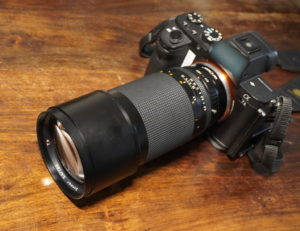
Anything but light and compact, and sporting a huge lens hood, the Carl Zeiss Jena 180mm f2,8 Olympia Sonnar lens made in East Germany:
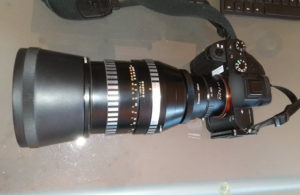
Sharpness in the center and corner of the Olympia Sonnar classic lenses
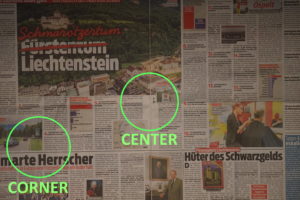
CENTER sharpness: Olympia Sonnar Carl Zeiss 180mm f2.8 Made in West Germany vs. Made in East Germany
The modern Sony FE 24-240mm zoom lens was added in the test and used at 180mm to compare the image quality of the classic lenses with a modern lens. Both Olympia Sonnar classic lenses were shot at open aperture f2.8 while the modern lens Sony 24-240mm was shot at open aperture f6.3. Not a fair comparison but the Olympia Sonnar Made in West Germany is much sharper at the center than the modern lens:
CORNER sharpness: Olympia Sonnar Carl Zeiss 180mm f2.8 Made in West Germany vs. Made in East Germany
Not a fair comparison for corner sharpness, the two Olympia Sonnar classic lenses were shot at open aperture f2.8 while the modern lens Sony 24-240mm was shot at open aperture f6.3. The Olympia Sonnar Made in West Germany is also sharper at the corner than the modern lens:
Some real life photos of the Olympia Sonnar Carl Zeiss 180mm f2.8 Made in West Germany vs. East Germany
The Carl Zeiss T* 180mm f2.8 Olympia Sonnar lens Made in West Germany shows a nice 3D-pop because of its micro contrast, especially in the last deer photos. Look how similar the bokehs of the two lenses are with the common predecessor lens made for the Olympic Games in Berlin 1936.
When you click on an image in the galleries, following buttons will allow you to select some features. Use Original-size to watch the photo in full resolution:
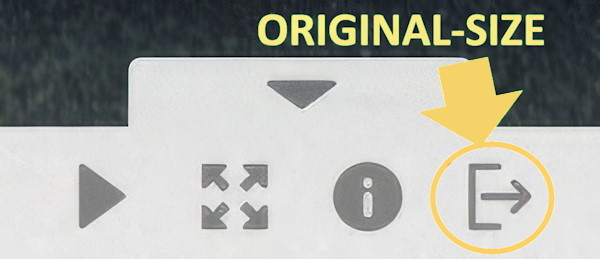
Slideshow | Fullscreen | Image-Info | Original-size
The bokeh in the back of the focused object
Take a look at the Ninja star bokeh of the Olympia Sonnar Made in West Germany at aperture f4 in the photo “A7 04299”. Compare the beautiful bokeh of the two Sonnar classic prime lenses with the onion style bokeh of the modern lens. Click on the photos to enlarge.
The bokeh in front of the focused object
The Olympia Sonnar Made in East Germany has the best bokeh in front of objects in focus and the Olympia Sonnar Made in West Germany has a strange Ninja star bokeh at aperture f4 in the photo “A7 04314”. Click on the photos to enlarge.
The bokeh of lenses in front and in the back of the focussed object is not necessarily the same, as you can see from above photographs. The Olympia Sonnar Carl Zeiss Jena 180mm f2.8 Made in East Germany excels in both bokeh disciplines.
Rundown
The final verdict is simple.
Olympia Sonnar Carl Zeiss T* 180mm f2.8 Made in West Germany

If you don’t mind spending EUR 400 or more, get a Carl Zeiss T* 180mm f2.8 Olympia Sonnar made in West Germany, which is much more compact and has a higher optical image quality as the test results shown above demonstrate nicely. The effective T* multi-coating is an additional plus of the Olympia Sonnar Made in West Germany and reduces flares and ghosting very well. You get a lot of micro contrast with this lens, and the lens performs quite well with Carl Zeiss Mutar II 2x tele converter and makes a 360mm lens out of it.
Pros
- excellent image quality in center and corner at aperture f2.8
- beautiful bokeh
- T* multi-coating
- high micro contrast and 3D-pop
- compact and light
- perfect for low light events and portrait shooting
- high quality 2x tele converter makes a 360mm lens out of it: Carl Zeiss Mutar II
Cons
- Ninja star bokeh at aperture f4
It’s better to buy the “MM” Multi-Mode version, which is typically technically improved compared to the older “AE” lenses. The West Germany Olympia Sonnar tested here is the MMG type of lens with a floating element (“G” stands for Germany). For a lower price you can get a “MMJ” lens, which was made in Japan (probably by Cosina) and delivers the same image quality.
Olympia Sonnar Carl Zeiss Jena 180mm f2.8 Made in East Germany
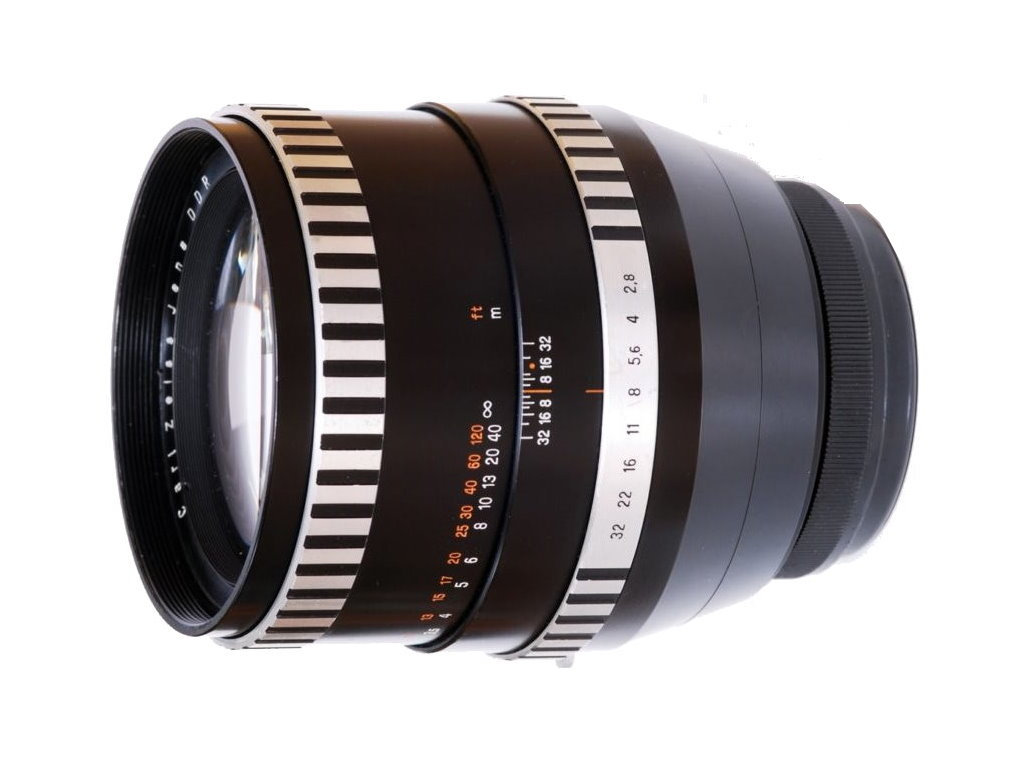
If you want to spend only around EUR 150 and don’t mind its size and weight, go for the Carl Zeiss Jena 180mm f2.8 Olympia Sonnar made in East Germany and adapt it to large format cameras up to 24 megapixel sensors. To adapt it to the Sony a6000 series with a APS-C sensor or to a Sony 7R type of full frame camera with 40 megapixels or more is not a good idea — the sweet spot of this lens does not deliver enough resolution.
Pros
- good image quality in center and corner at aperture f2.8
- very beautiful bokeh in front and in the back of focused objects
- perfect for low light events and portrait shooting
- inexpensive, approx. EUR 150
Cons
- prone to flares, thus never shoot without the huge lens hood
- very heavy and large with the mandatory huge lens hood
- low contrast
And the lessons are:
Spend more money on your lenses than on your camera body.
The Zeiss Olympia Sonnar classic lenses deliver an outstanding image quality and bokeh for a small amount of money!
Prague Spring in 1968
The tested Olympia Sonnar Carl Zeiss Jena 180mm f2.8 was made in East Germany in 1968. That same year, on the night of August 21-22, 200,000 troops and 2,000 tanks from the Soviet Union, Bulgaria, Poland and Hungary invaded Czechoslovakia and the capital Prague. The Soviet command refrained from drawing upon East German troops for fear of reviving memories of the Nazi invasion in 1939.

London agreement about the Zeiss brand in 1971

In the 1950s and 60s, Carl Zeiss in West Germany and Carl Zeiss in East Germany fought heavily in the courts for ownership of the Zeiss brand. Zeiss West Germany alone spent approx. 5 million Euro in litigation. In 1971 London, the parties settled: Carl Zeiss in Oberkochen would label their lenses “Carl Zeiss” with the origin “West Germany“, and Zeiss in East Germany would label theirs “Carl Zeiss Jena“. For the majority of countries, including the Commonwealth and Japan but excluding France, the same rule applied. (This is a very simplified version of the agreement. Write a comment below if you want to know more details.)
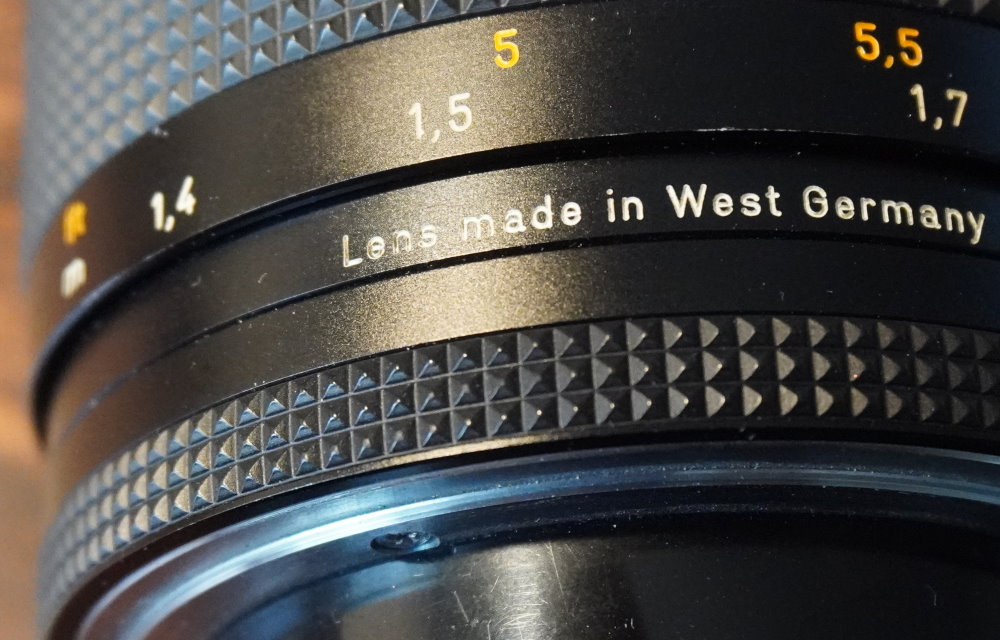
For future breach of agreement disputes, which repeatedly arose on the global market, the London agreement stipulated that the two sides should first discuss the cases with each other. This meant that face-to-face talks were held twice a year, alternately in Oberkochen, West Germany, and in Jena, East Germany.
This regular personal-style dialogue, which was said to have taken place during the daytime about the mutual violations of the London agreement and in the evening in a congenial atmosphere over dinners, was a first step towards the reunification of Zeiss.
“Mr. Gorbachev, tear down this wall” in 1987
The tested Olympia Sonnar Carl Zeiss T* 180mm f2.8 was Made in West Germany in 1987. That same year on the 12th of June, United States President Ronald Reagan famously declared in his speech before the Berlin Wall, “Mr. Gorbachev, tear down this wall“:
The fall of the Berlin Wall in 1989
On November 9, 1989 a commander of the GDR border crossing was misinformed by a public announcement of East Germany’s government official Günter Schabowski. As a consequence, the commander allowed the guards to open the checkpoints and let people through with little or no identity checking. Soon afterwards, a crowd of West Berliners jumped on top of the Wall and were soon joined by East German youngsters.
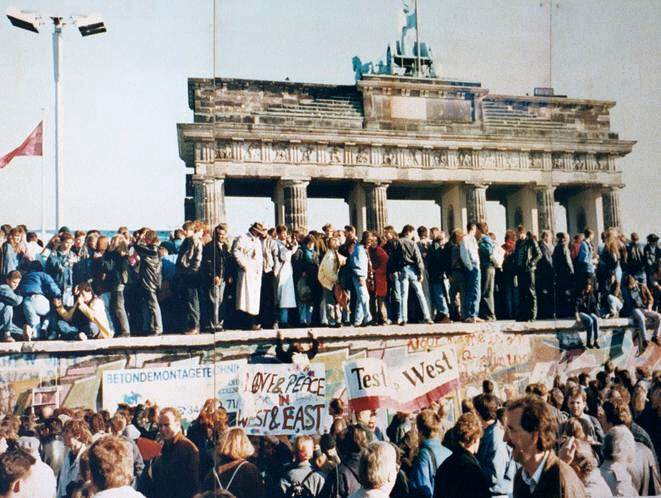
Germany reunites in 1990, and Zeiss in 1991
In 1990, West-Germany and East-Germany reunited. The entry of Carl Zeiss Jena GmbH into the Commercial Register in 1991 marked the reunification of the two separate Carl Zeiss companies.
A HAPPY ENDING
for Germany and Zeiss
❧
For more information about the famous Olympia Sonnar 180mm f2.8 lens, look here:
Zeiss Olympia Sonnar 180mm f2.8 lens adapted to a Sony a7ii full frame camera
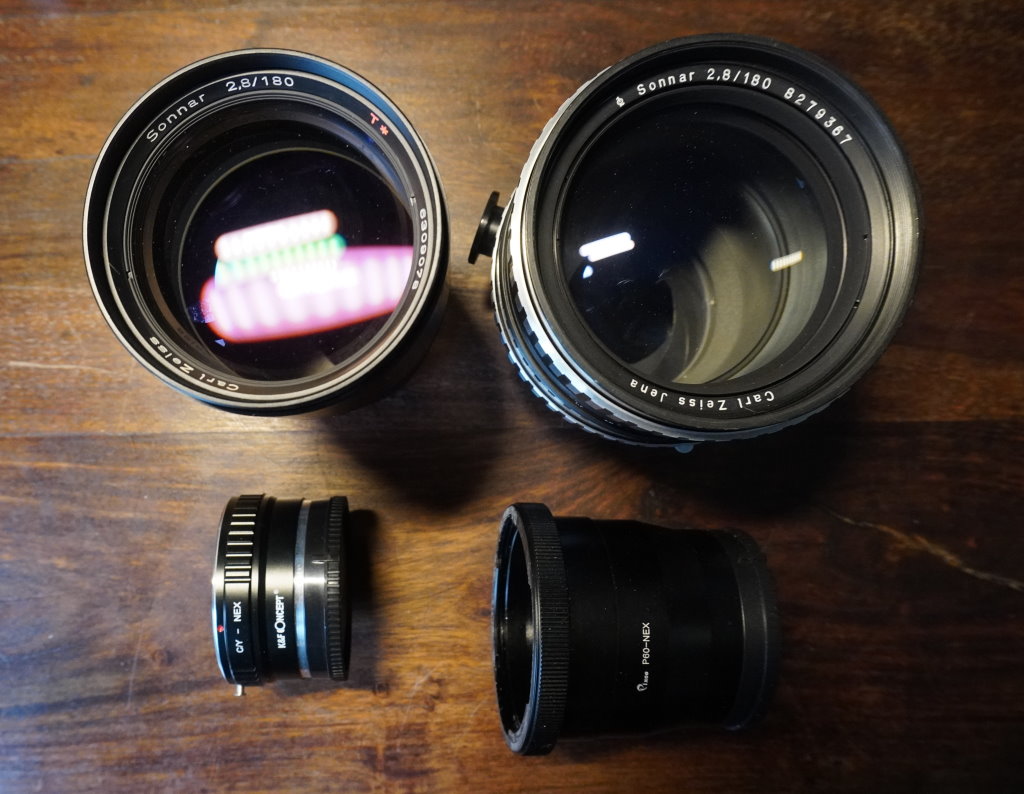
I am probably too late for a question, but here goes anyway. I know the East German version of the CZJ 180mm sonnar was designed for medium format cameras like the Pentacon Six TL My question is whether the West German version is the same. I am surprised by its much smaller size and weight and wonder if it is a lens for 35mm cameras. Thanks for your reply.
Yes, the East German version of the CZJ 180mm Sonnar was originally designed for medium format cameras like the Pentacon Six TL. The West German version, on the other hand, was made for 35mm systems, particularly for the Contax/Yashica mount. It was intended for film cameras such as the Contax RTS or my old Yashica FR-1.
With affordable adapters, such as Contax/Yashica to Sony E-mount, the West German Carl Zeiss 180mm f/2.8 delivers solid image quality on Sony’s mirrorless cameras, as long as you’re comfortable with manual focusing. A crop factor does not affect the focal length, so the CJZ 180mm lens will stay a 180mm lens when adapted.
Interestingly, I’ve found that the larger image circle of the medium format CZJ 180mm provides a unique benefit when mounted on 35mm film or full-frame mirrorless cameras. At wide apertures, the bokeh balls remain perfectly round even toward the edges of the frame, since only the central portion of the lens is used.
However, a drawback is that the non-matte aperture blades in the CZJ version can cause internal reflections, which may result in flares and reduced contrast in certain lighting conditions. And the size and weight of the CZJ 180 mm lens make it really difficult to carry around.